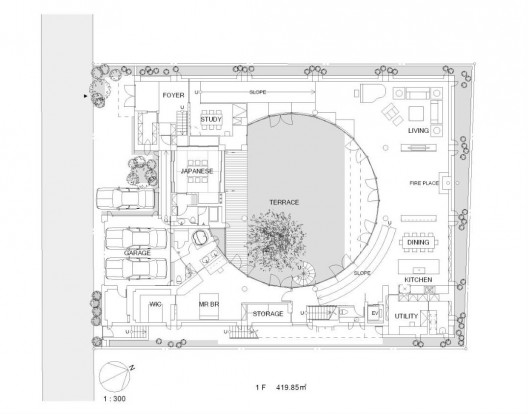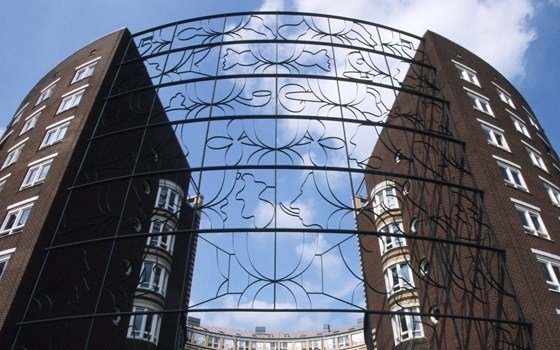 |
| Source: nationalarchives.gov.uk |
The Treasury Building - 1 Horse Guards Road, London, UK, 1919 designed by John Brydon
The large circular court in the middle of the building is derived from
Inigo Jones’ design for a new Whitehall Palace (never built) and is a
very distinctive piece of architecture. --
HM Treasury
 |
| Source: cobra-museum.nl |
The Cobra Museum of Modern Art, Amstelveen, Amsterdam, The Netherlands deisgned by Wim Quist
Inside, the museum’s open exhibition spaces are an unexpected bonus.
Their pervading daylight and visible closeness to nature set a positive
mood for looking at the art exhibits. --
official web site
The 'Barcelona' Housing Complex, KNSM Island, Amsterdam, The Netherlands deisgned by Bruno Albert
Belgian architect Bruno Albert is responsible for the massive
"Barcelona" housing block, located on Amsterdam's KNSM Island. The block
contains 325 residences and features an inner courtyard. --
goamsterdam
 |
| Source: archdaily.com |
Skanderborggade Day Care Centre, Copenhagen, Denmark, 2005 designed by Dorte Mandrup
The path of the summer sun from northeast to northwest traces the cut of the slope. The slope angle offers the best sun exposure to both the slope and the courtyard from the south and west. -- ArchDaily
 |
| Source: A 69 archdaily.com |
EggO House, Prague, Czech Republic, 2006 designed by A 69 Architects
The ovoid in this slab defines a focus around which the new house unwinds. It defines ego of the house, the fundamental of which is not the architectural, but the natural space of the original garden with preserved full-grown trees. -- ArchDaily
 |
| Source: Bill Timmerman archdaily.com |
 |
| Plan, Source: archdaily.com |
Hercules Public Library, Hercules, California, USA, 2006 designed by will bruder+PARTNERS
The library is organized around a white elliptical ‘sky garden’ with a café and reading areas around a tilted moss bed and magnolia tree. -- ArchDaily
 |
| Source: Yasuhiro Nukamura archdaily.com |
 |
| Plan, Source: archdaily.com |
House Like a Museum, Kamakura City, Kanagawa Prefecture, Japan, 2008 designed by Edward Suzuki Associates
the rectangular silhouette of the house was pushed to the boundary limits of the 776 square meter property in the center of which was placed a 15-meter diameter circular patio. The thrust of the planning was to allow each and every room to face and to have a view of this central garden. -- ArchDaily
 |
| Source: Gabriel Castro archdaily.com |
 |
| Plan, Source: archdaily.com |
Mine Museum and Archive’s Café, Belo Horizonte, Minas Gerais, Brasil, 2010 designed by MACh Arquitetos
....the café is partially underground. The concrete slab over the new space
configure a grassy square that best integrates existing buildings both
visually and functionally, providing better mutual access and flows
between the floors leveled by this re-designing of the public space. --
ArchDaily
 |
| Source: Nelson Kon archdaily.com |
 |
| Plan, Source: archdaily.com |
Livraria da Vila, São Paulo, Brazil, 2011 designed by Isay Weinfeld
The one-story 760 m2 space was organized from the creation of a small atrium, intended to magazines and paper supplies, which serves as reception hall, followed by a large round room giving access – through different height, different width passages – to three specialized literature rooms, an auditorium and a café, all independent venues one from the other, but organized as satellites of the large central space. -- ArchDaily
 |
| Source: Roland Halbe archdaily.com |
 |
| Plan, Source: archdaily.com |
Kid’s University in Gandía, Valencia, Spain, 2011 designed by Paredes Pedrosa
.... it respects the position of six existing white mulberry trees, arranging the classrooms around them and shaping a central lobulated courtyard. This courtyard will be the core of the Kid University, linking open spaces, covered areas and indoor rooms. -- ArchDaily
 |
| Source: Tang Yu archdaily.com |
Twin Trees Pavilion, Suzhou, Jiangsu Province, China, 2012 designed by Atelier Archmixing
Two big trees, a 20-year-old neem and a 15-year-old orange dominate the site and lend inspiration to the design as well as the name. Hybrid structure is employed in this project. All bricks from the dismantled pigpen are recycled to build the new walls in various laying patterns. A moderate yard is created around the trees by leaving an oval void in the slightly sloping concrete roof paralleling the graveled ground in original situation. -- ArchDaily
 |
| Source: Juan Carlos Loyo archdaily.com |
 |
| Plan, Source: archdaily.com |
Studio House Sabinos, Querétaro, México, 2012 designed by Juan Carlos Loyo Arquitectura
The use of a central (oval) patio to divide public and private spaces also allowed us to create a sculptural garden, that it’s flooded with rain water in summer for cooling. Cross ventilation and outside living is encouraged through the connection of inner spaces to terraces and gardens. -- ArchDaily
 |
| Source: Florian Kleinfenn archdaily.com |
 |
| Plan/Elevations, SOurce: archdaily.com |
Complex School in Bobigny, Bobigny, France, 2012 designed by Mikou Design Studio
....the scheme’s overall form is a spiral with a three-storey front on the north, designed to base the amenity’s institutional function on the pedestrian passage and the entrance esplanade, with gradual lightening of the built mass from the second upper floor downwards to the ground floor on the east and west, thereby allowing maximum sunlight into the classrooms and the school playgrounds. -- ArchDaily
 |
| Source: Luc Boegly archdaily.com |
 |
| Plan, Source: archdaily.com |
Les Trois Mondes School Group, Bordeaux, France, 2013 designed by Joly&Loiret
The ground floor is the primary school, earth. It is the “geological and topographical layer” with a connection to the mineral world. An argilo-calcareous stone base from the Gironde region occupies the centre of the playground The first floor is pre-school, the forest. It is the “biological layer”, designed to experience and discover the self and others. Hideouts and cabins abound.The second floor is the day care centre, the sky. It is the “atmospheric layer”, with its luminous, nuanced and translucent ambiance. -- ArchDaily
 |
| Source: Joonhwan Yoon archdaily.com |
 |
| Plan, Source: archdaily.com |
Nine Bridges “The Forum”, Seogwipo-si, Jeju-do, South Korea, 2013 designed by D·Lim Architects
The circular void is in the shape of the CJ’s official logo, which
represents notions of joy the meeting rooms and workspaces are
positioned around this core element to absorb natural daylight and
uplifting energy from the sky above. --
ArchDaily
 |
| Source: Iwan Baan archdaily.com |
 |
| Plan, Source: archdaily.com |
Courtyard House, Aurora, Oregon, USA, 2013 designed by NO ARCHITECTURE
Framing the central living spaces is a single courtyard. Planted to
continue the surrounding indigenous landscape, the courtyard is
conceived as a spatial divider, like a family camp, to consolidate and
share the conviviality and burdens of daily living without feeling
overcrowded at night. --
ArchDaily
 |
| Source: Yu Xu archdaily.com |
 |
| Site Plan, Source: archdaily.com |
Tiantai No.2 Primary School, Tiantai, Taizhou, Zhejiang, China, 2014 designed by LYCS Architecture
With land scarce, the 200m running track was projected onto the roof
level, giving an additional 3000+ sqm of usable area on the ground as
well as the oval shape of the school building, creating a sense of
inwardness and security for the students. --
ArchDaily




























No comments:
Post a Comment